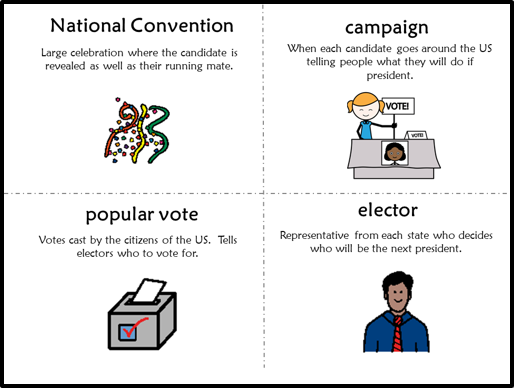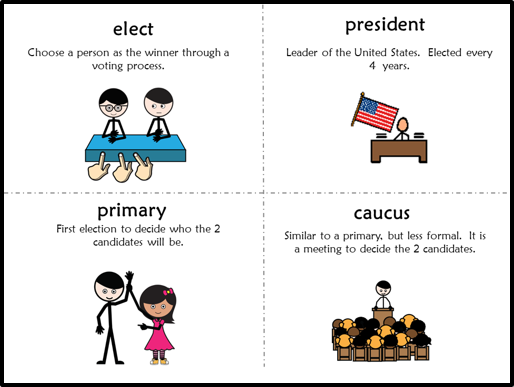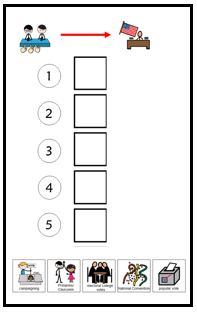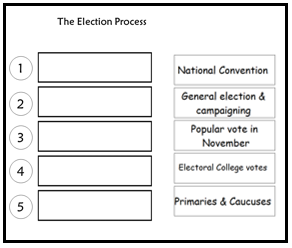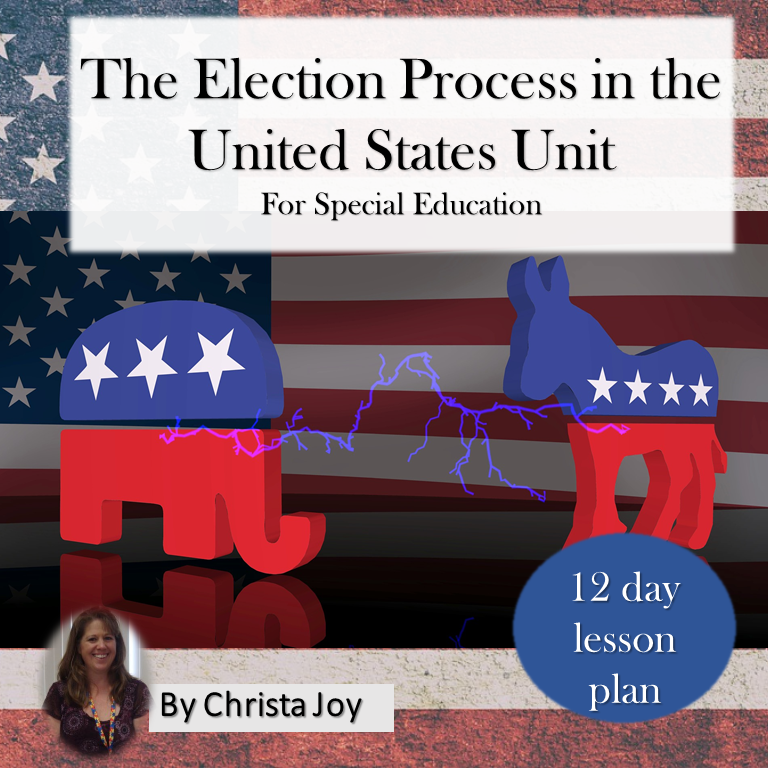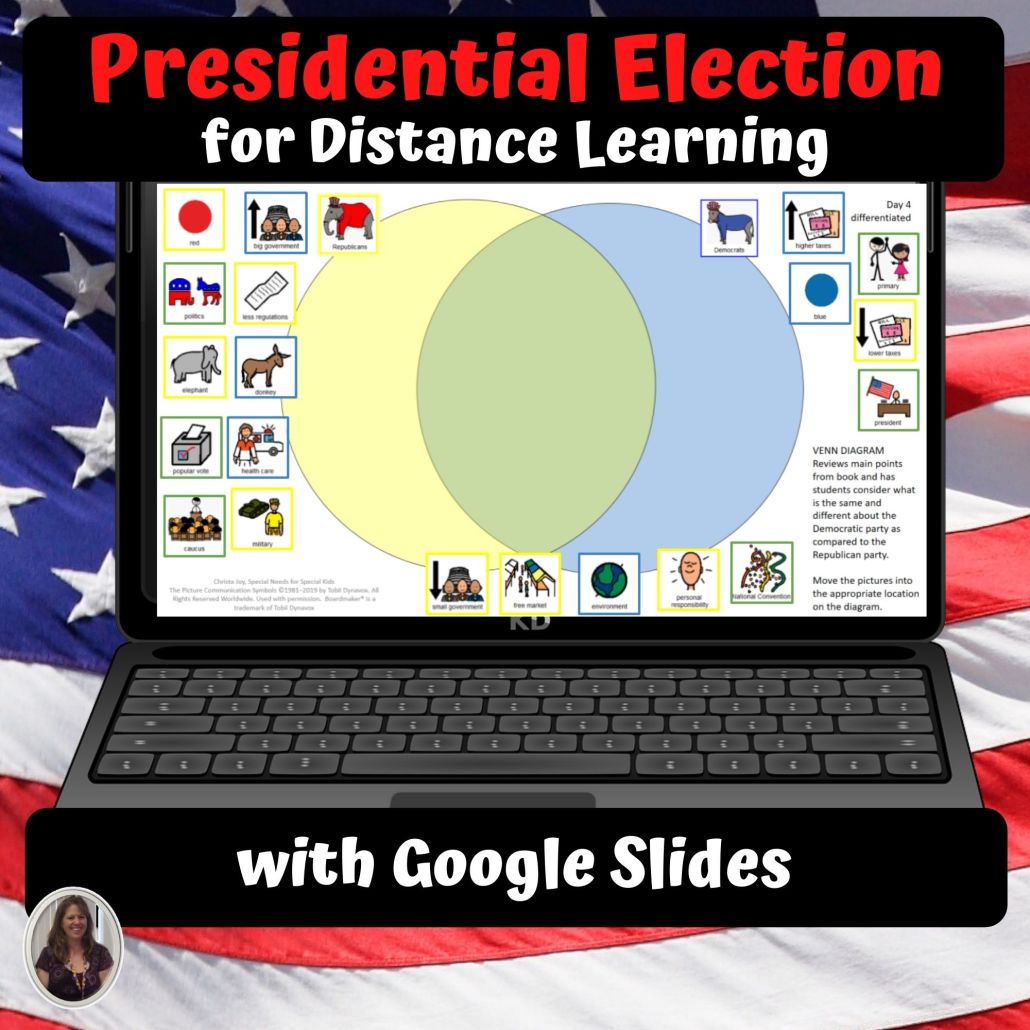This year the presidential election is November 3. If you are looking for some ways to teach your students about this democratic process without getting in the weeds of the politics, then here are some great ways to approach teaching about the upcoming election in your special ed classroom.
Textbook
I know most of you are thinking, what textbook? Either you are not given a textbook or the ones you are given are totally inappropriate and inaccessible to your students. That is why I like to create my own in powerpoint. It does not really take that long, and the benefits are long lasting. Not only do I read the book before every lesson (yes, every single lesson of my 12 day plan for this unit starts off reading the same book), but once I have theses books printed, laminated and put together, they go in my classroom library. Students LOVE looking through past books you have used in class. And because you read it aloud so many times, students can often read these to themselves or to a peer.
If you want a step by step guide on how to go about writing your own book, CLICK HERE.
Vocabulary
As with most topics, there is an entire new set of words that may be unfamiliar to many of our students. Most kids pick up new words from the people and the environment (including social media) around them. But, our kids often have trouble for various reasons being able to do the same. Therefore, we need to intentionally teach the vocabulary necessary to fully understand a new topic.
I like to read through the general ed material and pick out 15-20 words that I think my students will struggle with, but are worth learning. Next, I find a picture to pair the new word with, and come up with as simple a definition as possible. Oftentimes you will need to be creative in finding an appropriate image. Think like your students. What do want them to picture in their minds when they hear the word “campaign?”
Of course students will need a lot practice to learn these new words. In addition, they will need to use them in various ways to help with generalization and build some foundation for future use in other topics. That is why I like to do a group activity with any new vocabulary every day.
To get a list and directions for great group activities using vocabulary cards (or a board) CLICK HERE.
Activities
The next step is to think of an activity you can do each day that will tie together the book and the new vocabulary in a way that takes it a step further. For the election process, I am thinking of all the steps involved from states holding primaries to the general election in November. There are also the various parties involved and what the primary pillars or beliefs of each are. We can even see how different and similar these parties are through sorting activities and a Venn diagram.
I like to use pretty much the same activities for most of my units.
Here are some of my favorites: (*= included in this unit)
- Circle maps *
- Venn Diagrams *
- Sorting activities
- Matching activities
- Sequencing steps *
- Timelines
- Labeling
- Writing prompts *
If at all possible, I try to differentiate these so I have 2 levels of the same activity. That may mean including only correct answers for the circle map, or it may mean adding color coding. There are lots of ways you can differentiate these activities. I have 2 blog posts that go into more detail:
- 3 Ways to Add Differentiation CLICK HERE
- 10 Ways to use a Circle Map CLICK HERE
If you would like to download the activity: sequencing the steps to the presidential election, then click the button below. There is a link to a digital version of this activity as well!!
The main idea is what are the 3-5 big ideas you want your kids to walk away with. They are not going to be able to remember or process all the details and steps that go into a presidential election, but they can understand that it is a process that takes time and involves different groups wanting to achieve different goals.
Assessment
The final step is assessing how much your students have learned about the election process or if you need to do some reteaching. The first thing I like to do are some simple fill-in-the-blank worksheets. That way I can focus on a small amount of information and better identify areas my students got stuck. For this particular unit, I created one worksheet on the Democratic party, one on the Republican party, and two on the election process.
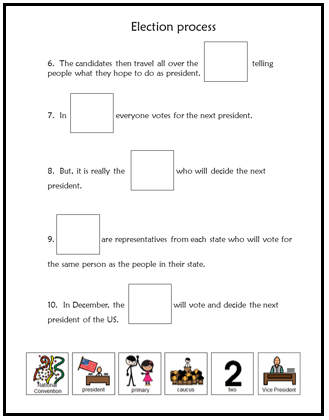
At the end of the unit, I typically give a 10 question assessment. I have several formats to accommodate various learning levels. The great thing, is you can (and should) give this assessment at the beginning of the unit as a pre-assessment. That way you have the perfect way to measure growth.

I know teaching about the presidential election process may seem very overwhelming in a special education setting. This is especially true if you have students who are reading at an early elementary level, or perhaps are non-readers. I hope this post gave you some encouragement and ideas.
Of course, if you just need to save time, I have this unit ready to go. It is based on high school standards and comes in a printable/pdf format as well as a digital format. There are some great engaging activities included that will get your students truly involved in learning about the election process.
Check these units out here.

